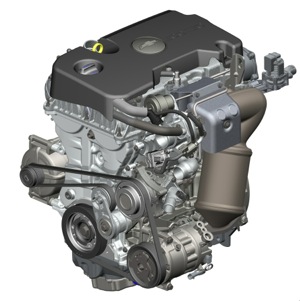Small, fuel-efficient 4-cylinder engines were the power
plant of choice for 55.8 percent of the new vehicles sold or leased at
retail in the U.S. market during the first half of 2013, according to
research data provided by the Power Information Network (PIN) from J.D. Power. That’s up 1.7 percentage points from the sales mix of 4-cylinder engines in 2012.
J.D. Power says consumers are demanding better fuel economy from their
vehicles due to higher gas prices at the pump, and also are lured by
better-performing powertrains that still offer oomph through direct
injection and turbocharging.
Eco-friendliness also is a concern. Automakers are adding a larger
percentage of smaller, more fuel-efficient powertrains (PIN defines
small engines as 3-, 4- and 5-cylinder blocks) in compacts, midsize
vehicles and even light trucks to meet the federal government’s upcoming
stricter Corporate Average Fuel Economy (CAFE) requirements (54.5 mpg
by 2025).
Recently, J.D. Power compiled some of the changes in powertrain
penetration tracked since 2008. Following are a few of the more
interesting details about the brands or nameplates that offer the most
4-cylinder engines in its lineup and which brand is working on
3-cylinder engine options:
• In 2008, there were five nameplates with more than 90 percent
small-engine penetration in the U.S. market. Today, there are 11.
• Five years ago, 10 nameplates did not even have engine options smaller
than 6-cylinders. Today, only three brands in the U.S. market do not
offer small engine choices in their lineups.
• Four brands have 100 percent small-engine penetration in the U.S. market: Mini, Smart, Fiat and Scion
• Volkswagen, Subaru, Hyundai and Kia have well above 90 percent small-engine penetration.
• GM’s Buick did not even offer a 4-cylinder engine in 2008, but now the brand has more than 50 percent in its sales mix.
• Among the Premium brands, Audi has the highest 4-cylinder penetration,
followed by BMW, which did not offer a single 4-cylinder engine in
2008.
Changeover to Smaller Engines Rises Dramatically During Past Five Years
During the five-year period between 2008 and 2013, the percentage of
4-cylinder engines has increased by 13.1 percentage points in J.D.
Power’s PIN retail sales mix, while the percentage of 6-cylinder engine
installations has dropped by 7.8 percentage points from 2008. In
addition, sales of vehicles with those larger V8 engines have dropped
4.9 percent since 2008.
In the future, smaller powertrains may take other configurations. Only
one auto brand in the U.S. market – Smart – sells models equipped with
3-cylinder engines, although the number of brands offering these small
engines is about to expand. Ford will soon offer a 1.0L, 3-cylinder
EcoBoost engine in the Fiesta sub-compact car, and The Detroit News
reported recently that General Motors is planning to introduce
3-cylinder engines in cars in the United States during the next few
years as well.










